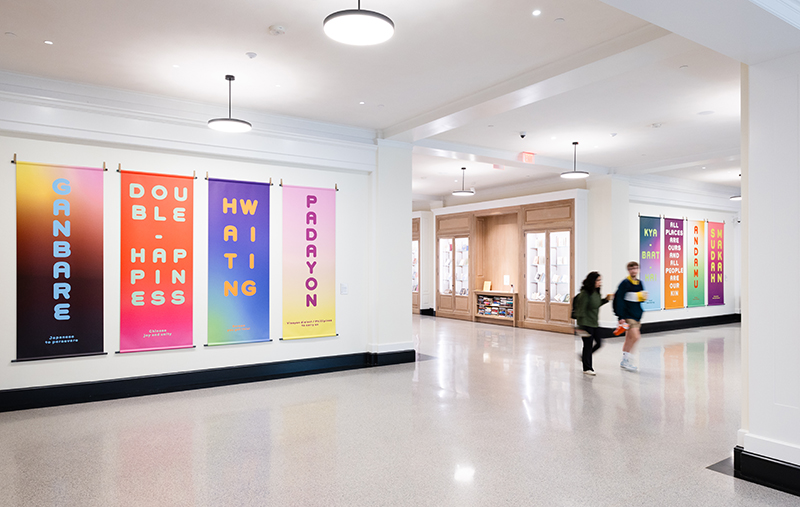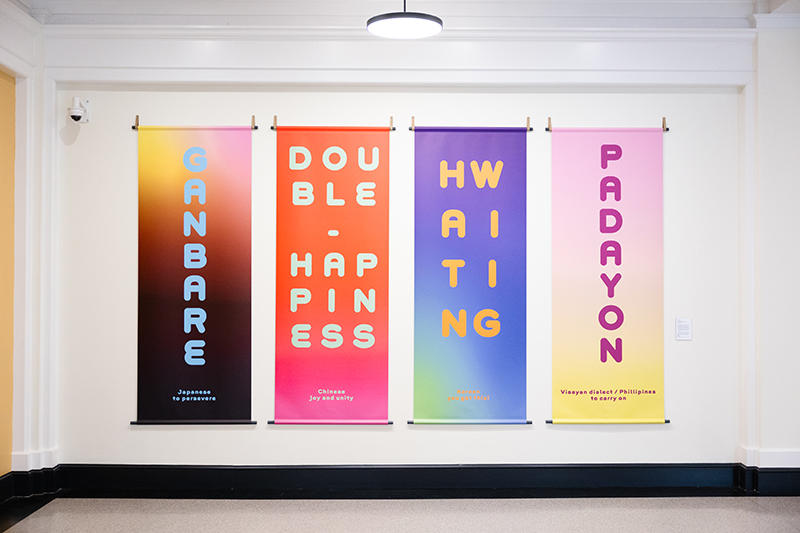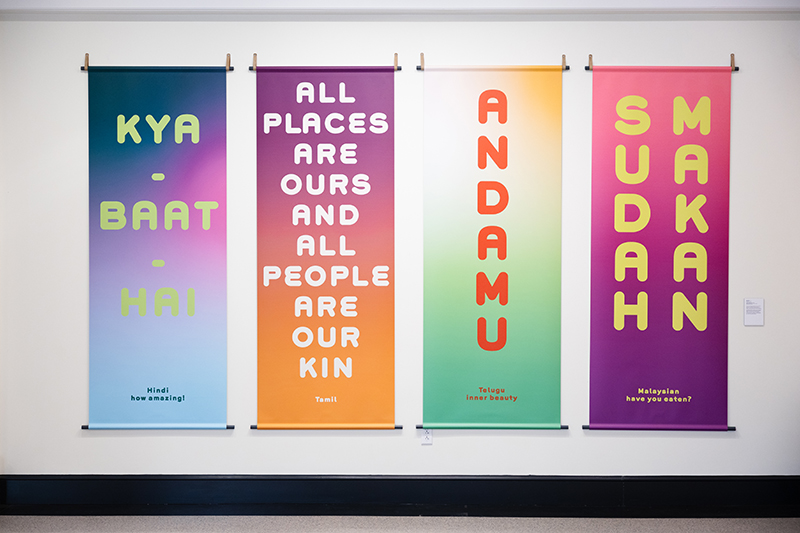They are bright, eye-catching, inviting: eight colorful banners on the second floor of Shannon Library call out visitors with greetings and phrases in languages that represent the University’s Asian, Pacific Islander, and South Asian American (APISAA) community.
The art installation, titled “Double Happiness,” after a traditional Chinese ligature often used to symbolize marriage, was created by Amy Chan, an abstract painter and UVA Associate Professor of Studio Art. On April 12, the UVA community is invited to an art reception celebrating Chan’s installation, to be held in the study courts on the second floor of Shannon from 2 to 4 p.m. Remarks begin at 2:15 p.m. and light refreshments will be served.

For those who can’t visit the installation in person, the text on the banners reads, from left to right:
Ganbare, Japanese, to persevere
Double Happiness, Chinese, joy and unity
Hwaiting, Korean, you got this!
Padayon, Visayan dialect / Philippines, to carry on
Kya baat hai, Hindi, how amazing!
All places are ours and all people are our kin, Tamil
Andamu, Telugu, inner beauty
Sudah makan, Malaysian, have you eaten?
The initial idea for the work came from a group of APISAA undergraduate students who met with UVA Student Success Librarians Cecelia Parks and Haley Gillilan for weekly dinners during the fall 2022 semester. The purpose of those dinners was to give the students a place to discuss their experiences at UVA and to brainstorm ideas for how the Library could be more welcoming to their community. The installation will remain up through the Fall 2024 semester.
“The students discussed how they would love to see more contemporary Asian or Asian American art in Library spaces,” said Parks. “They really liked the idea of a mural or another large-scale piece of public art in the renovated main library. … The end result is the beautiful display you see today,” Parks said.
Chan, Parks and Gillilan submitted a proposal for the installation to the newly formed Art in Library Spaces Committee, whose mission is “to create inclusive artistic spaces for University staff, faculty, and students as well as members of the Charlottesville community.” The committee includes members from not only the Library, but the Fralin Museum, the Kluge-Ruhe Aboriginal Art Collection, UVA Arts and the School of Architecture, as well as members of the Charlottesville arts community. The “Double Happiness” proposal was the first one accepted by the committee. “Double Happiness” was also sponsored by UVA Arts and the Office of the Provost & the Vice Provost for the Arts.
“We’re delighted that Professor Chan’s piece kicks off this important initiative and glad to have been connected to her work through Library staff committed to making student voices heard,” said Catalina Piatt-Esguerra, the Library’s Associate Dean for Inclusion, Diversity, Equity & Accessibility and Chair of the Art in Library Spaces Committee. “We hope that Art in Library Spaces continues to explore the ways visual display can contribute to inclusive space-making in Shannon Library.”
Ahead of the reception celebration, we spoke with Chan, Parks, and Gillilan, about “Double Happiness” and the experience of bringing a student idea to life. Our discussion is below.
Q. Can you walk me through the process of this art installation? How were the phrases chosen?
Chan: This piece was initiated by Haley and Cecelia, who conducted a focus group with APISAA students in which there was a clear desire to have more representation in public spaces. Representing the Asian American community has always been important to me, and I enjoy the new audiences that public projects allow my work to reach.
For this piece I reached out to numerous student organizations that serve the APISAA population at UVA with a call for sayings, colloquial phrases, or greetings that are important in their language of origin. I received some wonderful submissions and edited them down to eight, representing a range of languages. I chose phrases that were poetic, funny, and universal, in the hopes of connecting with the viewer’s own experience. My original intention was to combine imagery with the text, but I decided to let the text stand on its own.

Q. How did you decide which banners would be in English and which would be in the original languages?
Chan: This was an artistic decision. There are six panels with phonetic spellings or the original language, and two panels translated into English. The two I chose to translate stood out as the most poetic and moving. They are “double happiness” from Chinese, and “all places are ours and all people are our kin” from Tamil. I wanted the majority English speaking visitors to be able to engage with the spirit of these sentiments from afar and be drawn in to investigate the piece more fully. The six phonetic panels are phrases that represent more casual conversation.
I was also wary of having the piece look like one of those airport signs that translate the word “welcome” into many languages. It is important to me that the viewer can recognize the more expressive tone of the piece.
Q. What are the materials you used in creating the installation? And can you talk about your color choices and font choices?
Chan: The piece is digitally printed vinyl, constructed into eight scrolls. The installation format mimics the Chinese tradition of hanging scrolls in an interior space.
I love color and am influenced by the boldness of 1980s and ’90s popular culture. I am always exploring the edges of color harmony in my painting and that palette translates to what I’ve done here. Likewise, the bubble-like font offers a bit of humor to the piece, which is important in my work.
Q. What are some of your favorite pieces in the exhibition?
Parks: I don’t have a singular favorite piece. I love how bright and colorful and modern the panels are, and I love how they fit perfectly into the space. I love seeing how people react to it when they see it for the first time. Amy did an incredible job.
Gillilan: It’s also hard to say what my favorite piece in the exhibition is, because I think what makes it so gorgeous is how all the colorful panels fit together. I am a little partial to the Japanese phrase, “ganbare,” because I have Japanese heritage. Sending a picture of the piece to my Japanese American mother was a really special moment. I’m hoping she can see it in person soon! I agree with Cecelia, it has been so emotionally resonant to watch people walk onto the second floor of the library and stop in their tracks to observe the art.

Q. What would you most like visitors to know about this installation?
Chan: “Double Happiness” is a celebration of the joy we find through connection, and a reminder of home that we share with the UVA community. I am very grateful for to all the wonderful people at the Library who have helped me create this piece.
Q. Anything else you’d like to add?
Gillilan: Working with Amy has been a privilege. I love that we were able to include an artist in the UVA community for this project. It’s also been incredibly meaningful to bring a student idea to life. The students we worked with were so perceptive and passionate. It was a formative experience to hear their feedback, and to work to incorporate their perspective into remarkable change in our library space.
